2000 BMW 323Ci CONVERTIBLE key
[x] Cancel search: keyPage 4 of 199
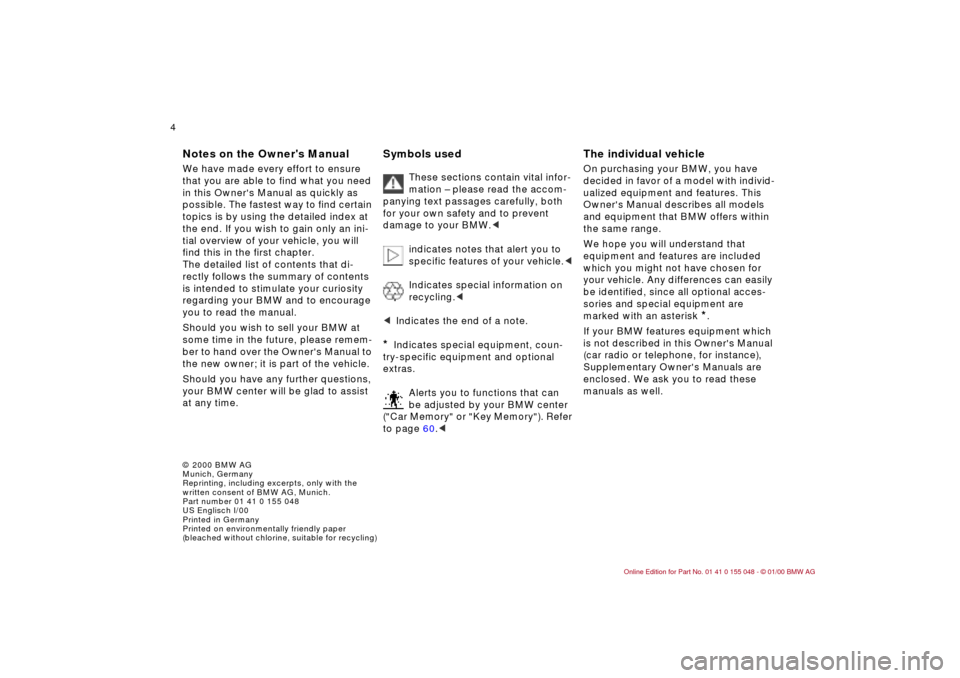
© 2000 BMW AG
Munich, Germany
Reprinting, including excerpts, only with the
written consent of BMW AG, Munich.
Part number 01 41 0 155 048
US Englisch I/00
Printed in Germany
Printed on environmentally friendly paper
(bleached without chlorine, suitable for recycling)
4n
Notes on the Owner's Manual
We have made every effort to ensure
that you are able to find what you need
in this Owner's Manual as quickly as
possible. The fastest way to find certain
topics is by using the detailed index at
the end. If you wish to gain only an ini-
tial overview of your vehicle, you will
find this in the first chapter.
The detailed list of contents that di-
rectly follows the summary of contents
is intended to stimulate your curiosity
regarding your BMW and to encourage
you to read the manual.
Should you wish to sell your BMW at
some time in the future, please remem-
ber to hand over the Owner's Manual to
the new owner; it is part of the vehicle.
Should you have any further questions,
your BMW center will be glad to assist
at any time.
Symbols used
These sections contain vital infor-
mation – please read the accom-
panying text passages carefully, both
for your own safety and to prevent
damage to your BMW.
<
indicates notes that alert you to
specific features of your vehicle.
<
Indicates special information on
recycling.
<
<
Indicates the end of a note.
*
Indicates special equipment, coun-
try-specific equipment and optional
extras.
Alerts you to functions that can
be adjusted by your BMW center
("Car Memory" or "Key Memory"). Refer
to page 60.
<
The individual vehicle
On purchasing your BMW, you have
decided in favor of a model with individ-
ualized equipment and features. This
Owner's Manual describes all models
and equipment that BMW offers within
the same range.
We hope you will understand that
equipment and features are included
which you might not have chosen for
your vehicle. Any differences can easily
be identified, since all optional acces-
sories and special equipment are
marked with an asterisk
*
.
If your BMW features equipment which
is not described in this Owner's Manual
(car radio or telephone, for instance),
Supplementary Owner's Manuals are
enclosed. We ask you to read these
manuals as well.
Notes
Symbols
The individual vehicle
Page 10 of 199

Contents
Overview
Controls and features
Cockpit16
Instrument cluster18
Indicator and warning lamps20
Multifunction steering wheel
(MFL)24
Hazard warning flashers25
Warning triangle25
First-aid kit25
Refueling26
Fuel specifications27
Tire inflation pressure27
Opening and closing:
Keys32
Electronic vehicle
immobilizer33
Central locking system34
Opening and closing – from
outside34
Opening and closing – from
inside38
Luggage compartment lid39
Luggage compartment40
Alarm system42
Electric power windows44
Manual convertible top45
The fully automatic convertible
top49
Wind deflector51
Adjustments:
Seats53
Seat and mirror memory57
Steering wheel58
Mirrors58
Car Memory, Key Memory60
Passenger safety systems:
Safety belts61
ISOFIX Attachment of the
child seat62
Airbags63
Child restraints66
Installing a child restraint
system67
Rollover protection system68
Driving:
Steering/Ignition lock70
Starting the engine70
Switch off the engine71
Parking brake72
Manual transmission73
Automatic transmission with
Steptronic74
Turn signal indicator/
Headlamp flasher77
Washer/Wiper system/
Rain sensor77
Rear window defroster79
Cruise control80
Everything under control:
Odometer82
Tachometer82
Energy Control82
Fuel gauge83
Coolant temperature gauge83
Service Interval Display83
Check Control84
Clock84
Onboard computer85
Technology for safety and
driving convenience:
Park Distance Control (PDC)87
Dynamic Stability Control
(DSC)88
Tire Pressure Control (RDC)89
Contents
Page 20 of 199
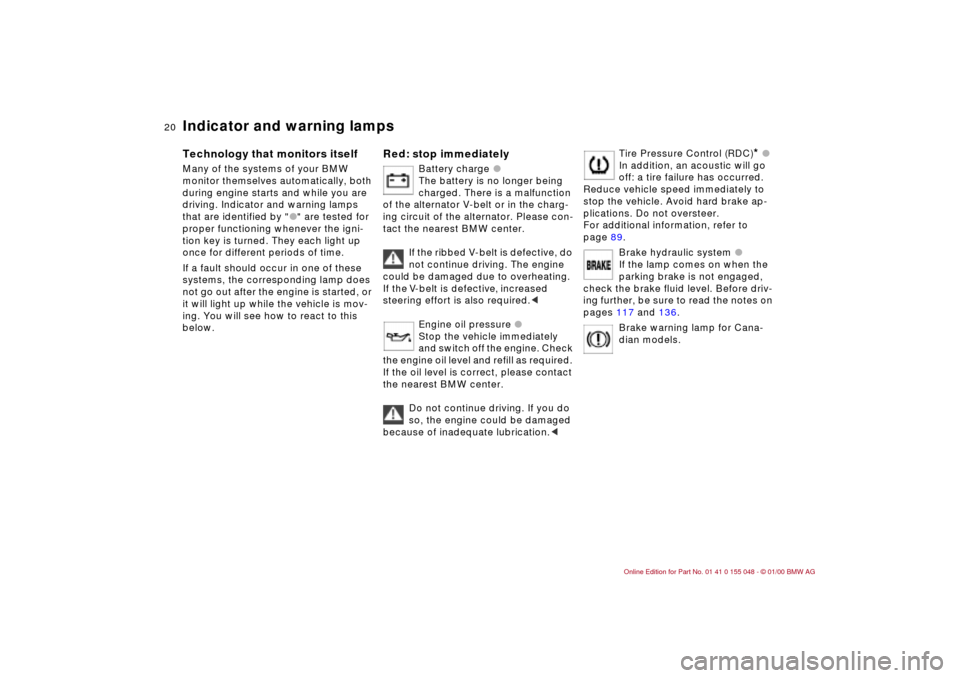
20n
Indicator and warning lamps
Technology that monitors itself
Many of the systems of your BMW
monitor themselves automatically, both
during engine starts and while you are
driving. Indicator and warning lamps
that are identified by "
l
" are tested for
proper functioning whenever the igni-
tion key is turned. They each light up
once for different periods of time.
If a fault should occur in one of these
systems, the corresponding lamp does
not go out after the engine is started, or
it will light up while the vehicle is mov-
ing. You will see how to react to this
below.
Red: stop immediately
Battery charge
l
The battery is no longer being
charged. There is a malfunction
of the alternator V-belt or in the charg-
ing circuit of the alternator. Please con-
tact the nearest BMW center.
If the ribbed V-belt is defective, do
not continue driving. The engine
could be damaged due to overheating.
If the V-belt is defective, increased
steering effort is also required.<
Engine oil pressure
l
Stop the vehicle immediately
and switch off the engine. Check
the engine oil level and refill as required.
If the oil level is correct, please contact
the nearest BMW center.
Do not continue driving. If you do
so, the engine could be damaged
because of inadequate lubrication.<
Tire Pressure Control (RDC)
* l
In addition, an acoustic will go
off: a tire failure has occurred.
Reduce vehicle speed immediately to
stop the vehicle. Avoid hard brake ap-
plications. Do not oversteer.
For additional information, refer to
page 89.
Brake hydraulic system l
If the lamp comes on when the
parking brake is not engaged,
check the brake fluid level. Before driv-
ing further, be sure to read the notes on
pages 117 and 136.
Brake warning lamp for Cana-
dian models.
Page 25 of 199
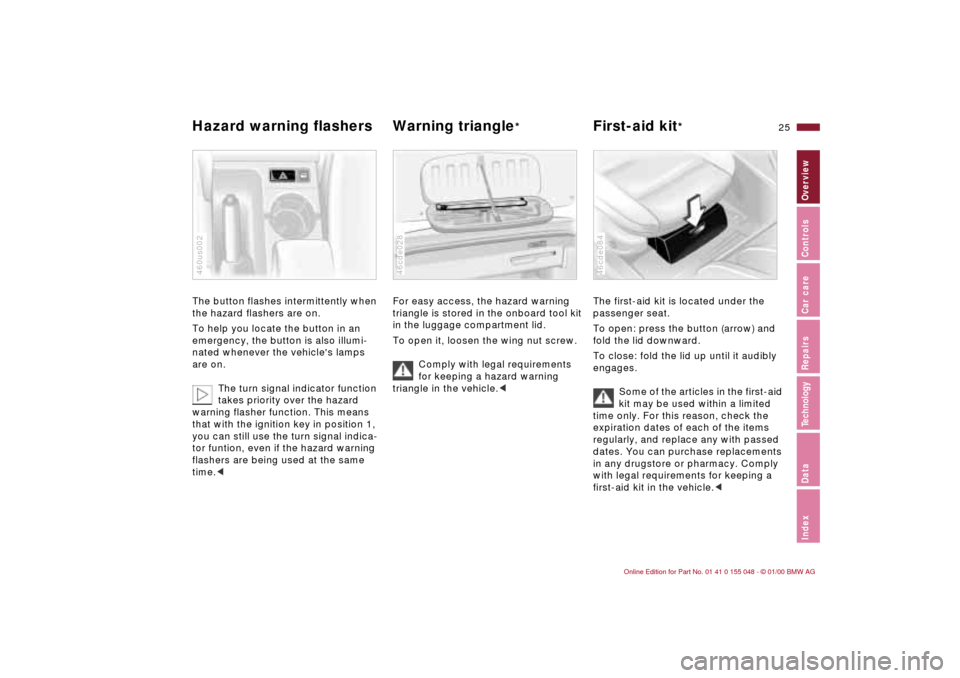
25n
IndexDataTechnologyRepairsCar careControlsOverview
Hazard warning flashers Warning triangle
*
First-aid kit
*
The button flashes intermittently when
the hazard flashers are on.
To help you locate the button in an
emergency, the button is also illumi-
nated whenever the vehicle's lamps
are on.
The turn signal indicator function
takes priority over the hazard
warning flasher function. This means
that with the ignition key in position 1,
you can still use the turn signal indica-
tor funtion, even if the hazard warning
flashers are being used at the same
time.< 460us002
For easy access, the hazard warning
triangle is stored in the onboard tool kit
in the luggage compartment lid.
To open it, loosen the wing nut screw.
Comply with legal requirements
for keeping a hazard warning
triangle in the vehicle.<46cde028
The first-aid kit is located under the
passenger seat.
To open: press the button (arrow) and
fold the lid downward.
To close: fold the lid up until it audibly
engages.
Some of the articles in the first-aid
kit may be used within a limited
time only. For this reason, check the
expiration dates of each of the items
regularly, and replace any with passed
dates. You can purchase replacements
in any drugstore or pharmacy. Comply
with legal requirements for keeping a
first-aid kit in the vehicle.< 46cde084
Page 30 of 199
30n
Opening and closing:
Keys32
Electronic vehicle immobilizer33
Central locking system34
Opening and closing – from
outside34
Opening and closing – from
inside38
Luggage compartment lid39
Luggage compartment40
Alarm system42
Electric power windows44
Manual convertible top45
The fully automatic
convertible top49
Wind deflector51
Adjustments:
Seats53
Seat and mirror memory57
Steering wheel58
Mirrors58
Car Memory, Key Memory60
Passenger safety systems:
Safety belts61
ISOFIX Attachment of
the child seat62
Airbags63
Child restraints66
Installing a child restraint
system67
Rollover protection system68
Controls
Page 32 of 199
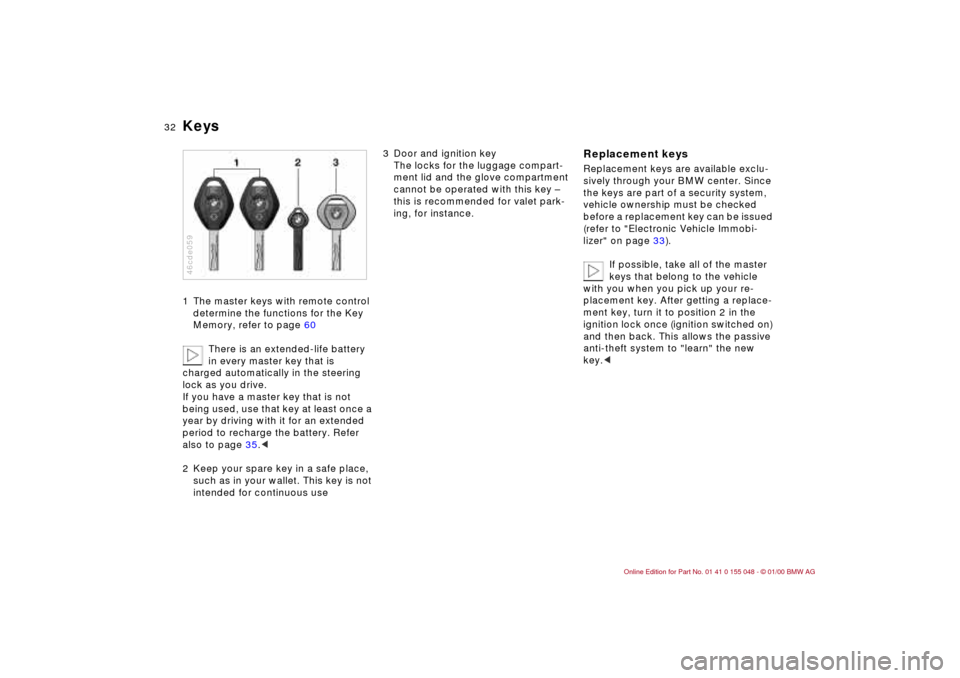
32n
Keys1 The master keys with remote control
determine the functions for the Key
Memory, refer to page 60
There is an extended-life battery
in every master key that is
charged automatically in the steering
lock as you drive.
If you have a master key that is not
being used, use that key at least once a
year by driving with it for an extended
period to recharge the battery. Refer
also to page 35.<
2 Keep your spare key in a safe place,
such as in your wallet. This key is not
intended for continuous use 46cde059
3 Door and ignition key
The locks for the luggage compart-
ment lid and the glove compartment
cannot be operated with this key –
this is recommended for valet park-
ing, for instance.
Replacement keysReplacement keys are available exclu-
sively through your BMW center. Since
the keys are part of a security system,
vehicle ownership must be checked
before a replacement key can be issued
(refer to "Electronic Vehicle Immobi-
lizer" on page 33).
If possible, take all of the master
keys that belong to the vehicle
with you when you pick up your re-
placement key. After getting a replace-
ment key, turn it to position 2 in the
ignition lock once (ignition switched on)
and then back. This allows the passive
anti-theft system to "learn" the new
key.<
Page 33 of 199
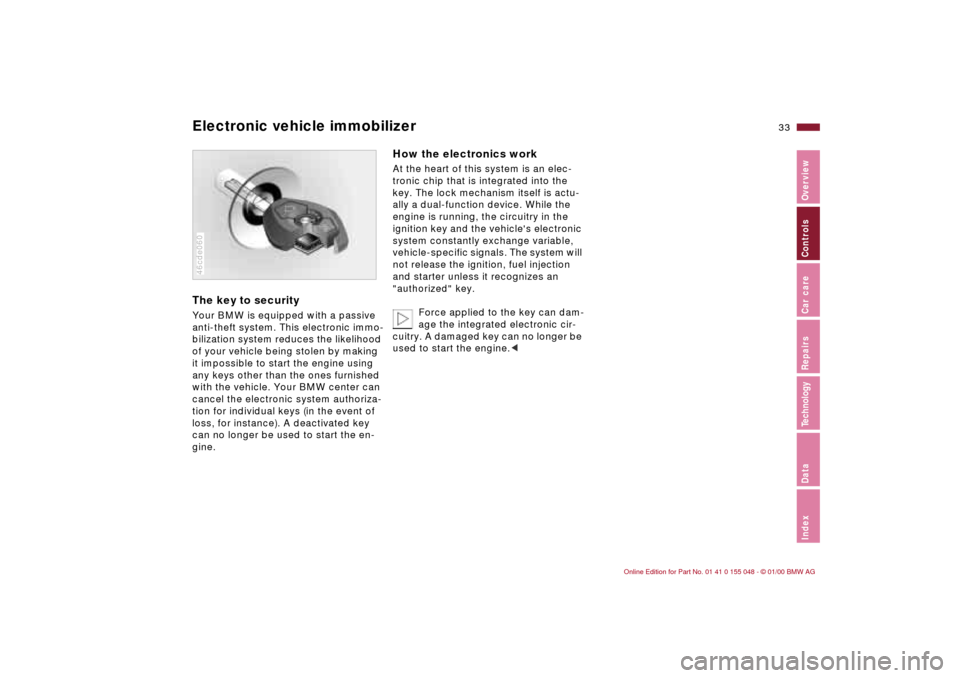
33n
IndexDataTechnologyRepairsCar careControlsOverview
Electronic vehicle immobilizer The key to securityYour BMW is equipped with a passive
anti-theft system. This electronic immo-
bilization system reduces the likelihood
of your vehicle being stolen by making
it impossible to start the engine using
any keys other than the ones furnished
with the vehicle. Your BMW center can
cancel the electronic system authoriza-
tion for individual keys (in the event of
loss, for instance). A deactivated key
can no longer be used to start the en-
gine.46cde060
How the electronics workAt the heart of this system is an elec-
tronic chip that is integrated into the
key. The lock mechanism itself is actu-
ally a dual-function device. While the
engine is running, the circuitry in the
ignition key and the vehicle's electronic
system constantly exchange variable,
vehicle-specific signals. The system will
not release the ignition, fuel injection
and starter unless it recognizes an
"authorized" key.
Force applied to the key can dam-
age the integrated electronic cir-
cuitry. A damaged key can no longer be
used to start the engine.<
Page 34 of 199
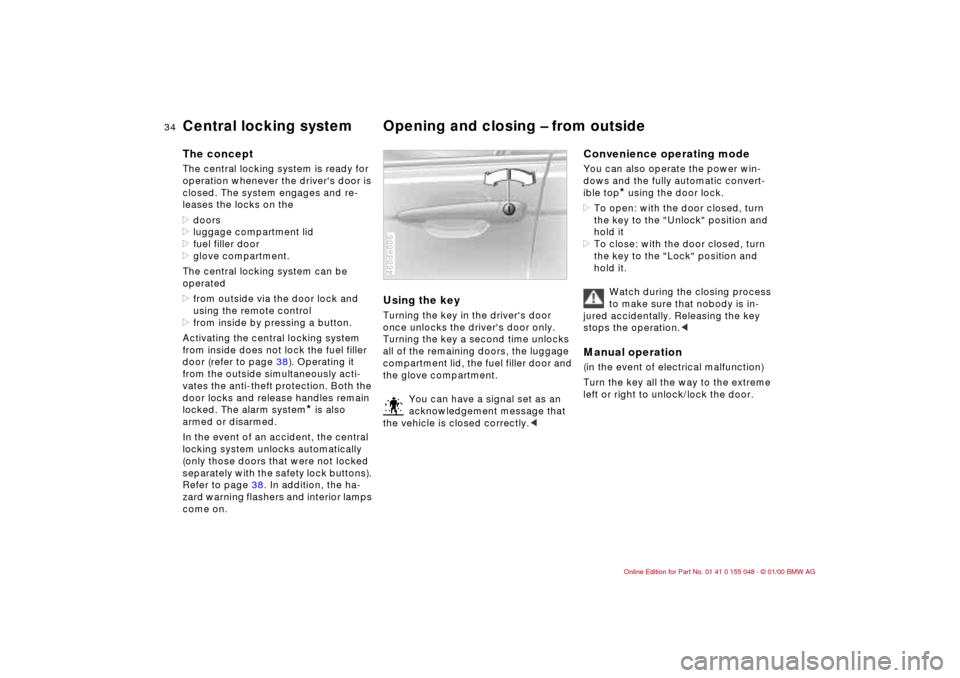
34n
Central locking system Opening and closing – from outside The conceptThe central locking system is ready for
operation whenever the driver's door is
closed. The system engages and re-
leases the locks on the
>doors
>luggage compartment lid
>fuel filler door
>glove compartment.
The central locking system can be
operated
>from outside via the door lock and
using the remote control
>from inside by pressing a button.
Activating the central locking system
from inside does not lock the fuel filler
door (refer to page 38). Operating it
from the outside simultaneously acti-
vates the anti-theft protection. Both the
door locks and release handles remain
locked. The alarm system
* is also
armed or disarmed.
In the event of an accident, the central
locking system unlocks automatically
(only those doors that were not locked
separately with the safety lock buttons).
Refer to page 38. In addition, the ha-
zard warning flashers and interior lamps
come on.
Using the keyTurning the key in the driver's door
once unlocks the driver's door only.
Turning the key a second time unlocks
all of the remaining doors, the luggage
compartment lid, the fuel filler door and
the glove compartment.
You can have a signal set as an
acknowledgement message that
the vehicle is closed correctly.<460de006
Convenience operating modeYou can also operate the power win-
dows and the fully automatic convert-
ible top
* using the door lock.
>To open: with the door closed, turn
the key to the "Unlock" position and
hold it
>To close: with the door closed, turn
the key to the "Lock" position and
hold it.
Watch during the closing process
to make sure that nobody is in-
jured accidentally. Releasing the key
stops the operation.<
Manual operation (in the event of electrical malfunction)
Turn the key all the way to the extreme
left or right to unlock/lock the door.